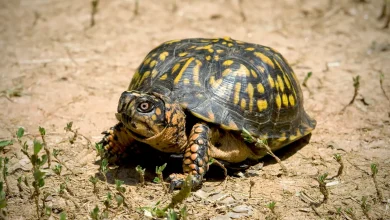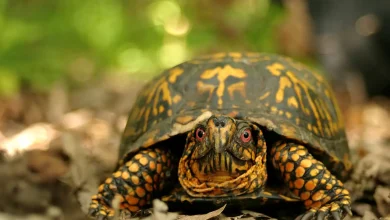Three Toed Box Turtle (Terrapene carolina triunguis)
The Three Toed Box Turtle is a subspecies of the common box turtle. It gets its common name from its back feet, which have three toes.
- Terrapene carolina triunguis, Agassiz 1857
Table of Contents
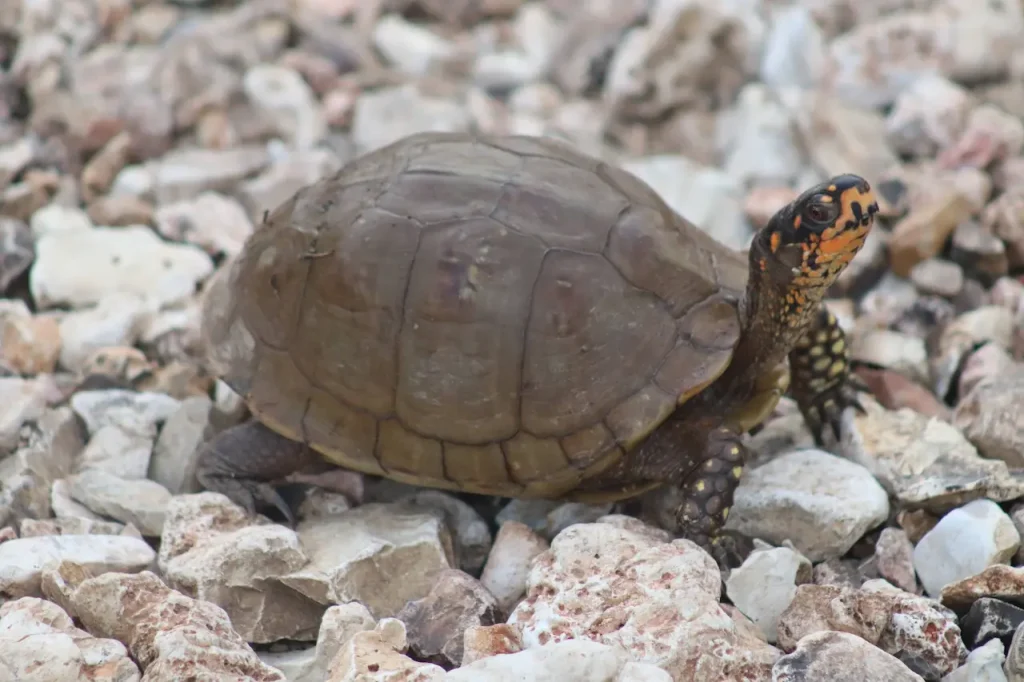
Three Toed Box Turtle Distribution
Three Toed Box Turtles are very common in the pet trade. They are one of the more adaptive subspecies of box turtle and have an easier time living in captivity throughout the country; compared to other box turtles.
The easiest place to find a pet Three Toed Box Turtle is the south-central region of the United States, where they are native and also very easy to breed in captivity. They can often be found for sale in other areas as well. never take a box turtle from the will to keep as a pet. It is illegal.
They can cross-breed with Common/Eastern Box Turtles. Some confusion occurs when these hybrid box turtles enter the pet trade and people have difficulty identifying them as a Three-Toed Box Turtle or a Common Box Turtle.
Three Toed Box Turtle Habitat
Three Toed Box Turtles are native to the southern-central region of the United States. They can be found further than this, both in the wild and in captivity. (Those in the wild were likely released from captivity and have been adapting to new areas, a rare accomplishment for box turtles who are often extremely fragile in unfamiliar environments).
It is the official reptile of the state of Missouri.
Like many box turtles, they like to inhabit humid areas such as marshes and grasslands. Unlike most subspecies of Box Turtles, they are willing to wander from familiar surroundings and will migrate to different areas to maintain a preferred level of humidity in their surroundings.
They like to live near shallow water where they can drink, soak, hydrate, and hunt for insects.
Body
The defining characteristic of this turtle is its toes. It has three toes on its back feet, thus why it is known as the Three-Toed Box Turtle. Hybrid Three-Toed Box Turtles who have interbred with Common Box Turtles sometimes have four toes instead of three.
As a subspecies of box turtle, it has a hinged shell that enables it to conceal its limbs and head within its body entirely. They have a domed shell and can grow to about five inches in length.
The Three-Toed Box Turtle does not typically have coloured markings that are as bright as other sub-species. Often their shells and limbs have basic colors like olive and light brown. Some brighter markings appear occasionally, such as yellow, red, or orange spots on the neck and head of males.
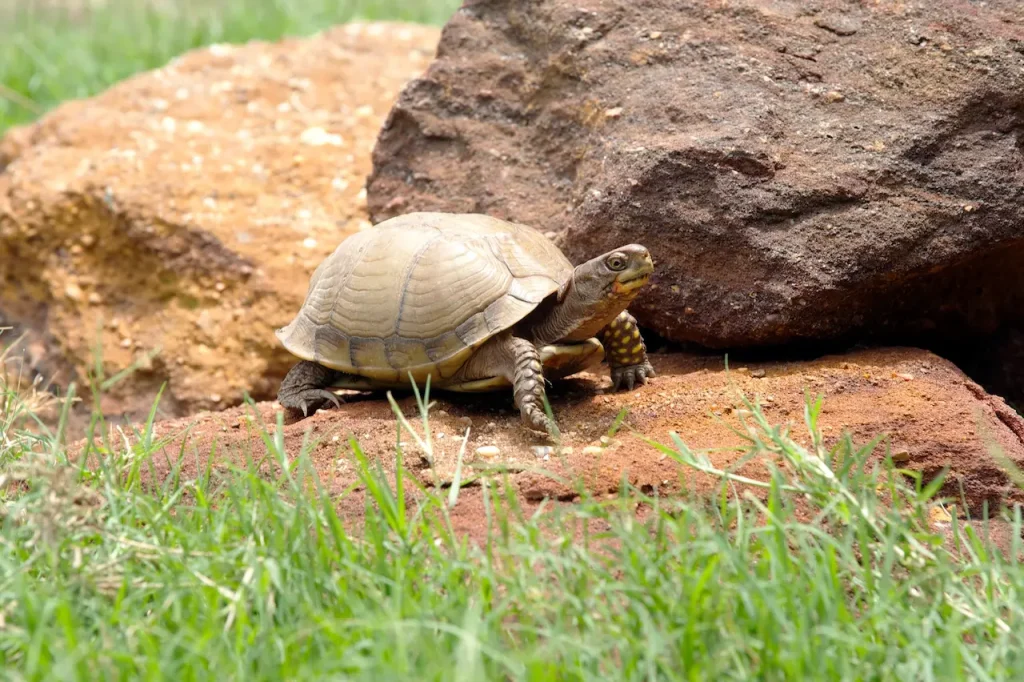
Sexing a Three Toed Box Turtle
As just mentioned, colourful markings on the head and neck such as yellow, red, or orange spots can be an indication that the specimen is male.
A trick that works for most box turtles is to look at the bottom of their shell. Males have a concave curve on the bottom of their shell that helps them mount a female, whereas females have a flatter surface on their bottom shell by comparison.
What Does Three Toed Box Turtle Eat?
Three Toed Box Turtles are omnivores, meaning they eat both meat and plant matter. They get most of their meat from insects, which they hunt for in still bodies of shallow water. Examples include snails, slugs, crickets, grasshoppers, and roaches. For plant matter, they can eat things like moss, certain types of grass and lettuce, fallen fruit, berries, and mushrooms.
How Old Can a Three Toed Box Turtle Get?
Most subspecies of Box Turtle can live close to a hundred years in the wild. Very few Box Turtles reach this age in captivity, due in part to the stress of being taken from their home environment. Since Three Toed Box Turtles are not as attached to their birth environment, they can live more happily in captivity than other subspecies. A pet Three Toed Box Turtle may live longer within your artificial enclosure than a different type of Box Turtle, but a hundred-year lifespan is still unlikely. Their exact lifespan in captivity varies immensely from one owner and specimen to another.
Keeping Three Toed Box Turtles as Pets
Three Toed Box Turtles are quite common in the United States and are easy to obtain as pets. While they are more durable in captivity than other subspecies, they still have a lot of needs that have to be met if they’re going to survive.
Housing a Three Toed Box Turtle
The top priority of keeping any Box Turtle is constructing a good enclosure that will encourage good health and happiness.
Reptiles cannot regulate their body heat, so you have to produce an ideal temperature for them within their enclosure. You should have a heat bulb that produces a temperature of about 85f. This should be to one side of the enclosure so that they can move closer to or further away from the heat source as needed.
Water and humidity are important. There must be fresh water within the enclosure constantly. There should be a large shallow body of water that they can soak in. Use a spray bottle on the enclosure several times daily to keep the humidity level up.
Box Turtles do not like glass, and will often try to climb through it pointlessly. Your enclosure should have walls that they cannot see through to give them better peace of mind.
Be sure to have plenty of artificial brush and bedding that they can burrow into.
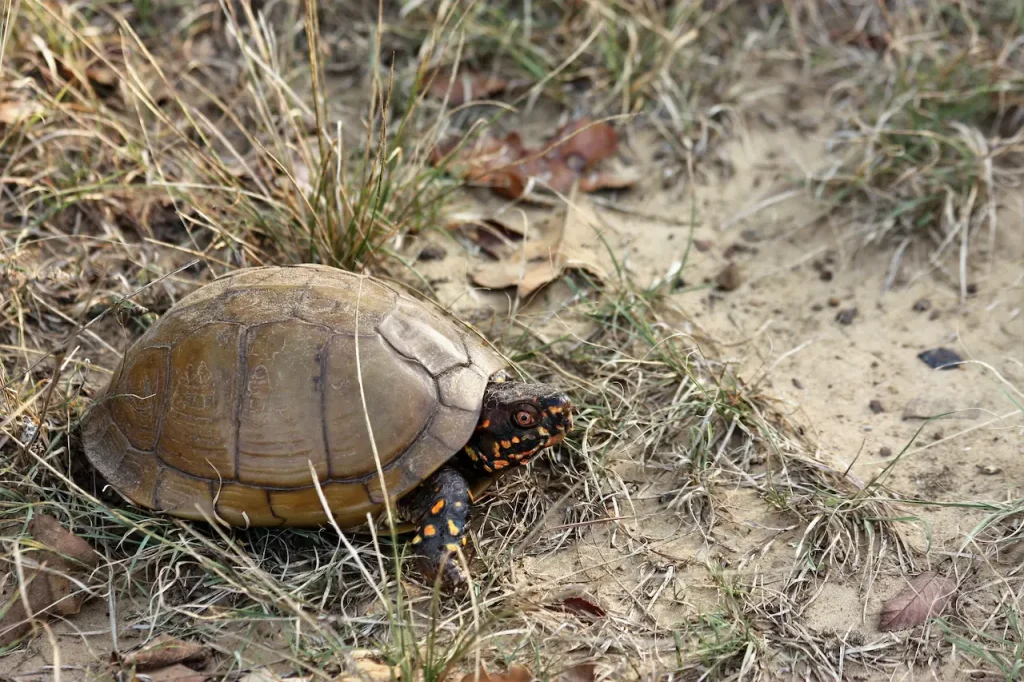
Feeding a Three Toed Box Turtle
Your Three Toed Box Turtle must be fed a balance of meat and plant matter. There are various feeder insects you can pick up at pet stores such as crickets and grubs. For plant matter, they love things like lettuce and fruit.
Parasites
If you get a Three Toed Box Turtle as a pet, be sure to take them to the vet right away to make sure they don’t have any parasites. Parasites can get under the scales of reptiles and are hard to deal with without professional help, and they can greatly hinder the health of your new pet.
References
- A. S. Lockley. 1948. Note on the three-toed box turtle. Copeia 1948(2):132
- Iverson, J. B. 1992. A Revised Checklist with Distribution Maps of the Turtles of the World
- Syntype: Agassiz, L. 1857. Contributions to the Natural History of the United States of America, Volume 1, Part 2, North American Testudinata. 1: 445
- Jen, Roger; Joseph T. Collins (1991) [1958]. Roger T.Peterson, ed. Peterson’s Field Guide to Reptiles and Amphibians, Eastern and Central American. (illustrators) Isabelle H. Conant & Tom R. Johnson (3rd edition ed.). Boston, USA: Houghton Mifflin Company. p. 53. ISBN 0-395-58389-6
